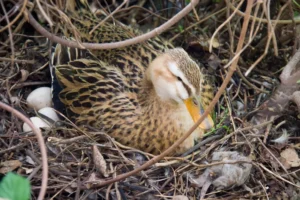Mallard ducks are found all over North America and their nesting habits have been well-documented. They typically nest in freshwater marshes, but will also use other wetland habitats such as ponds and lakes.
The female mallard duck builds her nest out of vegetation, using reeds, grasses, and twigs to create a bowl-shaped structure. She lines the nest with down feathers plucked from her own body to keep her eggs warm.
Mallard ducks typically nest in areas with dense vegetation near water. The female builds the nest by gathering plant material and lining it with down feathers.
She then lays her eggs (usually 8-12) and incubates them for about 28 days. Once the duckling’s hatch, they follow their mother to find food and shelter.

Do Mallard Duck Return to the Same Place?
Do Mallard Duck Return to the Same Place? Mallard ducks are a common sight in many ponds and lakes across North America. But what happens when they migrate south for the winter?
Do they return to the same place year after year? It turns out that mallards are pretty loyal to their home turf.
A study conducted by the U.S. Geological Survey found that around 80% of mallards return to their natal pond (the one where they were born) to breed.
That’s a pretty impressive homing instinct! So why do some mallards end up somewhere else? It could be due to changes in the local environment, such as new development or pollution.
Or it could be because of competition from other ducks for mates or food. Whatever the reason, it seems that most mallards prefer to stick close to home.
What Time of Year Do Mallard Ducks Lay Eggs?
Mallard ducks lay eggs in the springtime, typically from March to May. The female will build a nest out of grass, feathers, and down near the water’s edge, and lay anywhere from five to thirteen eggs in it.
Once all the eggs are laid, she will incubate them for about 28 days until they hatch.
How Do You Tell If a Duck is nesting?
When it comes time for a duck to lay her eggs, she will search for a secluded and safe place to build her nest. Once she has found the perfect spot, she will start to construct her nest by picking up pieces of vegetation and grass with her beak and arranging them into a cup-shaped structure.
Ducks will usually line their nests with soft materials like feathers in order to make it comfortable for the eggs.
If you suspect that a duck is nesting on your property, there are a few things you can look for to confirm it. First, check for a well-constructed nest that is lined with soft materials like feathers.
You may also see the duck sitting on the nest or coming and going from the area regularly.
If you want to be absolutely sure, you can try gently lifting up the duck to see if there are any eggs underneath her.
Where Do Mallard Duck Sleep at Night?
Mallard ducks are a type of waterfowl that can be found all over the world. Ducks are interesting creatures and have more behaviors than other types of birds. One behavior that is unique to ducks is where they sleep at night.
Mallard ducks usually sleep in the water, with their heads tucked under their wings. If the water is too cold or there is not enough food, they may move to a different location. Sometimes, mallards will even sleep in trees!
It is believed that ducks sleep with one eye open, so they can be aware of predators or other dangers. This allows them to keep safe and protect themselves when they are young.
Overall, mallard ducks have a unique way of sleeping at night compared to other birds. Their ability to adapt to their environment and keep safe makes them amazing creatures!
Does Mallard Ducks Sit on Their Eggs?
Yes, mallard ducks do sit on their eggs. The female will incubate the eggs for about 28 days before they hatch. During this time, she will not leave the nest except to eat and drink.
The male will stand guard nearby and help protect her from predators.
Conclusion
Mallard ducks typically nest in areas with dense vegetation near water. The female will build the nest out of grass, twigs, and leaves, and line it with down feathers. She will usually lay between 8 and 12 eggs per clutch.
Once the eggs hatch, the ducklings will leave the nest within 24 hours and follow their mother to find food and shelter.